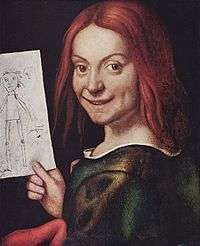Giovanni Francesco Caroto


Giovanni Francesco Caroto (1480 – 1555 or 1558) was an Italian painter of the Renaissance active mainly in his native city of Verona.
He initially apprenticed under Liberale da Verona (1445-1526/1529), a conservative painter infused with the style of Mantegna. Caroto after a stay in Milan, began responding to the other influences from Francesco Bonsignori, Leonardo da Vinci, Raphael, and Giulio Romano; but he never lost a certain individuality and his rich Veronese color. He is perhaps best known for having trained, along with the younger Antonio Badile, the prominent Mannerist painter, Paolo Veronese, who was active mainly in Venice.
Good examples of his art are in the Castello, Milan, the Chiesa de Carità, Mantua, in the Uffizi and Pitti, Florence, and in the museums of Dresden, Budapest, etc. His works are sometimes confused with those of his brother Giovanni, who was likewise a talented painter. Both were buried in Santa Maria in Organo in Verona.[1]
Notes
- ↑ Zannandreis, Diego (1891). Giuseppe Biadego, ed. Le vite dei pittori, scultori e architetti veronesi. Stabilimento Tipo-Litografico G. Franchini, Verona; Digitized by Googlebooks from University of California copy on Feb 22, 2007. pp. 66–69.
References
-
 This article incorporates text from a publication now in the public domain: Gilman, D. C.; Thurston, H. T.; Colby, F. M., eds. (1905). "article name needed". New International Encyclopedia (1st ed.). New York: Dodd, Mead.
This article incorporates text from a publication now in the public domain: Gilman, D. C.; Thurston, H. T.; Colby, F. M., eds. (1905). "article name needed". New International Encyclopedia (1st ed.). New York: Dodd, Mead.
External links
 Media related to Giovanni Francesco Caroto at Wikimedia Commons
Media related to Giovanni Francesco Caroto at Wikimedia Commons